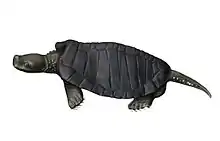| Eorhynchochelys Temporal range: Late Triassic, | |
|---|---|
 | |
| Life restoration of Eorhynchochelys sinensis | |
| Scientific classification | |
| Domain: | Eukaryota |
| Kingdom: | Animalia |
| Phylum: | Chordata |
| Class: | Reptilia |
| Clade: | Pantestudines |
| Genus: | †Eorhynchochelys Li et al., 2018 |
| Type species | |
| †Eorhynchochelys sinensis Li et al., 2018 | |
Eorhynchochelys (meaning "dawn-beaked turtle" in Greek) is an extinct genus of stem-turtle from the Late Triassic Xiaowa Formation (or Wayao Member of the Falang Formation) of southwestern China.
Description
Eorhynchochelys is notable for its unusual combination of a turtle-style skull and a conventional reptilian body. The skull, for example, has an edentulous beak typical of all members of Testudinata. However, the thorax region is markedly different from Pappochelys and Odontochelys and more similar to Eunotosaurus in lacking a shell, even though the ribs were wide and flat. The skull also has a single pair of holes behind the skull, unlike the presence of two pairs of holes in Pappochelys.[1][2][3] Unlike other stem-turtles, Eorhynchochelys had twelve dorsal vertebrae. It reached up to 1.8 m (5.9 ft) in total length, which is much larger than Pappochelys.[3]
References
- ↑ Li, Chun; Fraser, Nicholas C.; Rieppel, Olivier; Wu, Xiao-Chun (2018). "A Triassic stem turtle with an edentulous beak". Nature. 560 (7719): 476–479. Bibcode:2018Natur.560..476L. doi:10.1038/s41586-018-0419-1. PMID 30135526. S2CID 52067286.
- ↑ Rehm, Jeremy (2018). "230-million-year-old turtle fossil deepens mystery of reptile's origins". Nature. doi:10.1038/d41586-018-06012-0. S2CID 187604135.
- 1 2 Hans-Dieter Sues (August 6, 2019). The Rise of Reptiles. 320 Million Years of Evolution. Johns Hopkins University Press. p. 50. ISBN 9781421428680.

